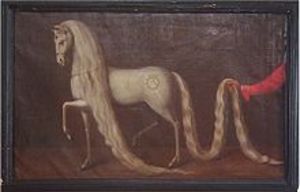The Oldenburg is an old breed that has had to change with consumer demand. Back in the 1600s, better roads called for a fast, sturdy and reliable animal to pull the greater number of carriages on those roads. Count Anton Gunther von Oldenburg (1603 – 1667) began to breed what he hoped would be the world’s best harness horse.
The Count, known by history as one of Lower Saxony’s best rulers, chose to breed horses because of the excellent grazing land available. German states already had access to hard-working and reliable horses, but the Count wanted a larger, flashier horse than those available. He began crossing Friesian mares, which he considered stylish but too heavy, with Andalusian, Danish, “Turkish”, Neapolitan stallions. There isn’t a “Turkish” horse breed, so the Count may have called Arabian or Barb horses “Turkish.”
Kranich
The Count owned an equine celebrity, a “half-breed” grey stallion named Kranich (German for crane). He had a Roman nose, a pink muzzle and a remarkably long mane and tail that dragged on the ground behind him. This mane and tail were very heavy and required a strong horse to not only cart it about, but do so in style. Kranich was a result of his early breeding programs. Kranich was unusual not only for his mane and tail but for his color. Most of the horses bred were black.
Kranich became the Count’s favorite horse. Although he was breeding harness horses, the Count rode Kranich. A portrait of him riding Kranlich survives. Kranlich lightened with age. Kranlich was considered one of the first Oldenburgs, although his portrait makes him appear more like a Lipizzaner than an Oldenburg. It is unknown if Kranlich died before the Count. The Count died without children, so the State took over his property and stables.
The New Oldenburg
By the 1800s, thoroughbreds, Cleveland Bays, Hanoverians and French Normans were added to the Oldenburg’s mix. After World War I, there was no longer a demand for carriage horses and the switch to a riding horse began. In 1959, thoroughbreds were added to make a large riding horse capable of winning in many horse sports like show jumping, dressage and eventing.
There are very few Alt-Oldenburgs (“Old Oldenburgs”) bred today. The new Oldenburg has a more sloping shoulder and a lighter build than Alt-Oldenburgs. The chest is deeper than of the Alt-Oldenburg. The head is also more like a thoroughbred’s. Prolific author and horseman Elwyn Hartley Edwards would describe the modern Oldenburg’s head as “plain but honest.” Modern Oldenburgs are a variety of colors, including pinto but are rarely grey and grow a mane and tail of normal proportions. Colts and geldings have to be named with the first letter of their sire’s name (For Play, by For Pleasure, for example) while fillies have to share the same first letter of their dam’s name.
Additional References
International Encyclopedia of Horse Breeds. Bonnie Hendricks. University of Oklahoma Press; 1995.
The Encyclopedia of Horses & Ponies. Tasmin Pickeral. Paragon Publishing; 1999.
Storey’s Illustrated Guide to 96 Horse Breeds of North America. Judith Dutson. Storey Publishing; 2005.
The Official Horse Breeds Standard Book. Fran Lynghaug. Voyageur; 2009.




